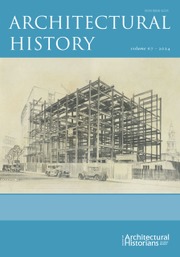No CrossRef data available.
Article contents
Towards a Chinese Christian University: The University of Nanking, 1912–31
Published online by Cambridge University Press: 03 June 2025
Abstract
The University of Nanking, established in 1910 by missionaries from the United States and built between 1912 and 1931, was one of the earliest Christian universities established in China. Its campus in Nanjing, in China’s eastern Jiangsu province, featured a combination of Beaux-Arts plan, local Chinese architectural styles and modern building techniques that both responded and contributed to rapid changes in the city’s socio-political context during the early twentieth century. Identifying and examining three trends in the planning and architectural design of the campus — westernisation, localisation and modernisation — this article argues that the university was actively involved in the transition of Nanjing from a regional urban centre of the Qing dynasty to the new capital of the Chinese republic (1912–49). The interaction of the three trends illuminates how a Chinese Christian university, as a new type of institution without parallels in traditional Chinese society, used western and Chinese theories and resources to produce modern educational space. The university’s efforts to modernise in the face of Nanjing’s then poor urban infrastructure and nascent building industry happened at various levels from infrastructure to tectonics, often achieved through the collective efforts of the western superintendent and Chinese workers and contractors. Influencing later attempts to modernise urban space and to develop a new architecture suitable for the new era in the country, the project represents a transitional moment in the architectural history of modern China when the cross-cultural exchange of knowledge between east Asia and the west brought new possibilities to Chinese buildings and cities.
Information
- Type
- Research Article
- Information
- Creative Commons
- This is an Open Access article, distributed under the terms of the Creative Commons Attribution-NonCommercial-NoDerivatives licence (https://creativecommons.org/licenses/by-nc-nd/4.0/), which permits non-commercial reuse, distribution, and reproduction in any medium, provided the original work is unaltered and is properly cited. The written permission of Cambridge University Press must be obtained for commercial re-use or in order to create a derivative work.
- Copyright
- © The Society of Architectural Historians of Great Britain 2025

